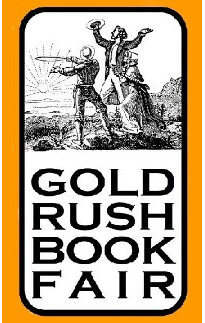11th Annual Gold Rush Book Fair May 14th
- by Bruce E. McKinney

On a Saturday in May a reunion of they whose lives revolve around books and works on paper will gather in Grass Valley, California for the 11th annual Gold Rush Book Fair. Exhibitors will travel as many as a thousand miles, spend the evening before the fair in the company of other exhibitors and listen to a talk by Robert Rulon-Miller who has flown in from Minneapolis. This fair is the work and measure of Tom Dunham who for the second year is handling all arrangements, having assumed the mantle from John Hardy who organized and ran the fair for nine years. Some few stalwart souls, Tom among them, against lengthening odds carry this book fair and others deeper into the decade. It is a tough fight for such fairs appeal to older collectors but have yet to attract the next generation in significant numbers.
Were it as simple transferring the collecting bug from father to son the process would involve work but less uncertainty. But it is not so easy. As we increasingly understand the next generation is an amorphous breed that defies easy description and may have no direct connection to previous collectors. This makes them difficult to find. They may browse websites, eBay or garage sales; do all these things or others. What they cannot often enough do anymore is visit bookshops and so this and other book fairs are of necessity becoming surrogates for a trade that has all but disappeared from Main Street.
In the now rapidly receding past bookshops abounded so the chance for casual encounters with collectible material were good. Even small cities had many used bookshops. Today we have the occasional bookshop, increasingly off the beaten track, often open by appointment and occupying second floor space.- visibility all but lost. As significantly the bookseller’s stock has changed. Increasing awareness, via bibliographies up to a decade ago and databases the past ten years, have made it possible for buyers and necessary for sellers to specialize. In the transition generalists have suffered mightily and their decline reduced the opportunities for nascent collectors to broadly peruse and absorb.
The fairs then provide, if only for a day or two, once or twice a year, the chance to browse extensive inventories, ask questions and make connections that may turn into enduring relationships. Today the new collector can on any day look online at crowds of ‘buy me-s’ but absent human interaction to help shape one’s thinking about what is collectible as well as how to go about it, such collecting may never mature into a serious pursuit. For this fairs provide the best opportunity.